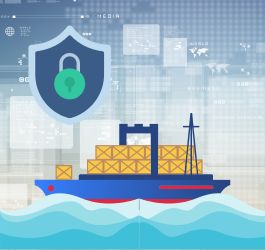As we are soon stepping into 2024, the maritime industry faces a mix of challenges and exciting prospects.
Balancing supply and demand, addressing environmental concerns, and coping with a shortage of skilled workers are among the issues at hand.
HOWEVER…
These challenges have sparked a surge of innovative solutions.

Looking ahead, the maritime sector is laser-focused on lessening its environmental impact. This means a significant shift towards cleaner energy sources and the widespread adoption of energy-efficient technologies.
It's a resolute commitment to reducing the industry's environmental footprint.
The maritime industry is undergoing a remarkable transformation, driven by the integration of advanced technologies. This includes the prominent role of artificial intelligence (AI), big data analytics, the Internet of Things (IoT), robotics, and blockchain. These innovations are reshaping the way maritime operations are conducted, paving the way for a more efficient and sustainable industry.
These are seamlessly woven into various aspects, elevating operational efficiency to new heights. They don't just boost productivity; they act as catalysts for innovative solutions to long standing maritime issues.
Moreover, the incorporation of immersive reality technologies, including augmented and virtual reality, is revolutionizing training, engineering, and inspection practices. These tailored solutions offer dynamic and hands-on learning experiences, ensuring maritime professionals are armed with the latest tools and knowledge.
This amalgamation of challenges, opportunities, and technological progress paints a vivid picture of a maritime industry that's not only resilient but also poised for a future defined by sustainability, efficiency, and adaptability.Table Of Contents
Top 10 Trends in the Maritime Industry (2024)
From the strategic integration of Artificial Intelligence (AI) to the accelerating adoption of clean energy solutions, the maritime landscape is evolving at a rapid pace.
In this guide, we embark on a journey through the top 10 trends that promise to revolutionize the maritime industry in 2024, shaping a future of efficiency, sustainability, and safety on the open waters.
Artificial Intelligence (AI) in Maritime Operations

The integration of Artificial Intelligence (AI) stands at the forefront of a transformative wave in maritime operations. Powered by machine learning algorithms, this technological leap is set to revolutionize the industry's landscape.
From refining route planning to automating critical tasks, AI is primed to elevate decision-making processes, all while embracing green technology for a more sustainable and environmentally-conscious future.
This seismic shift promises a maritime era characterized by enhanced safety, unprecedented efficiency, and cost-effectiveness. The analytical prowess of AI enables vessels to navigate intricate routes with unparalleled precision, factoring in dynamic variables such as weather conditions and traffic patterns in real time.
As a result, the industry is poised to experience a significant reduction in fuel consumption and emissions, marking a substantial leap towards a more eco-friendly shipping sector.
Additionally, AI-driven automation is set to streamline operations onboard ships, optimizing resource utilization and freeing up valuable time for crew members to focus on higher-level tasks.
From predictive maintenance to logistics management, the applications of AI in maritime operations are far-reaching and promise to revolutionize the way the industry operates.
By embracing AI, the maritime sector is not only future-proofing its operations but also contributing significantly to global sustainability efforts. This technological integration signifies a progressive leap towards a safer, greener, and economically efficient maritime industry.
Case study: Orca AI

In a historic milestone for maritime technology, Orca AI, in collaboration with Designing the Future of Full Autonomous Ships (DFFAS) and The Nippon Foundation, has achieved the world's inaugural autonomous commercial ship voyage through heavily trafficked waters.
It successfully completed a 790 km voyage around Tokyo Bay with human intervention required for ONLY 1% of the journey. In an impressive display of its capabilities, the ship autonomously averted between 400 and 500 potential collisions, showcasing the immense potential of autonomous maritime technology.
This achievement stands as a testament to the remarkable progress in autonomous ship technology and its potential to revolutionize the maritime industry.
Empowered by cutting-edge AI and deep learning, Orca AI's advanced safety navigation system was strategically installed on the vessel, effectively assuming the role of a 'human watchkeeper'.
This system delivers real-time capabilities for detection, tracking, classification, and range estimation, meticulously processing data from 18 onboard cameras that collectively provide comprehensive 360° coverage both day and night.
To refine its accuracy, Orca AI's algorithms underwent rigorous training using data amassed over a year from Suzaku, allowing them to adeptly discern targets even within the intricate coastal landscape of Japan.
Impressively, the information gleaned from these cameras is swiftly relayed to the fleet operations center in Tokyo, spanning hundreds of kilometers in real-time. This seamless integration of technology showcases a remarkable stride towards safer and more efficient maritime operations.
Clean Energy Revolution

The maritime industry is currently in the midst of a profound transformation, enthusiastically embracing a clean energy revolution.
This transition is led by the adoption of Liquefied Natural Gas (LNG), the integration of hydrogen fuel cells, and the development of fully electric vessels. Together, these technologies are at the forefront of a sweeping movement towards sustainable energy solutions.
Liquefied Natural Gas (LNG) is rapidly gaining ground as a formidable alternative to traditional fossil fuels. Its advantages lie in its lower emissions profile, particularly in terms of sulfur oxides and nitrogen oxides, making it a pivotal player in the industry's quest for greener operations.
In parallel, the integration of hydrogen fuel cells holds immense promise. By producing electricity through a chemical reaction between hydrogen and oxygen, these cells offer a clean, efficient, and potentially game-changing energy source for maritime applications.
However, the true milestone in this shift towards sustainability is the emergence of fully electric vessels. These vessels operate with zero direct emissions, primarily due to their advanced battery technologies.
This transition represents a monumental leap towards emissions reduction and the cultivation of a more eco-conscious maritime industry. It signifies not only a commitment to environmental stewardship but also a recognition of the pivotal role the maritime sector plays in fostering a sustainable global future.
Case study: E-ferry Ellen

The E-ferry Ellen stands as a groundbreaking achievement in the maritime industry, heralding a new era of sustainable transportation. This impressive vessel operates in Denmark and holds the distinction of being the world's largest all-electric ferry.
Its electric propulsion system represents a monumental leap towards reducing emissions and embracing cleaner, more efficient technologies.
Ellen's electric powertrain is a remarkable feat of engineering, enabling it to operate solely on electricity. This eliminates the need for traditional fossil fuels and significantly reduces the vessel's carbon footprint. With a length of 59 meters, it has the capacity to carry 200 passengers and 30 cars per voyage, showcasing the feasibility and scalability of electric propulsion in maritime transport.
Moreover, Ellen's electric propulsion system allows for smooth and virtually silent operation, minimizing noise pollution in sensitive coastal environments. The integration of cutting-edge battery technology ensures a reliable power source, enabling the ferry to navigate with precision and efficiency.
The success of the E-ferry Ellen serves as a powerful case study for the maritime industry, demonstrating that electric propulsion is not only viable but also highly effective in real-world operations.
It highlights the potential for widespread adoption of green technologies in the sector, paving the way for a more sustainable future in maritime transportation.
Maritime Robotics For Efficiency And Safety

In the maritime industry, robots have found diverse applications, ranging from routine cleaning and maintenance tasks to the operation of fully autonomous vessels, devoid of a pilot, captain, or any onboard crew, heralding a new era defined by heightened efficiency and safety.
These pioneering technologies are poised to take center stage, fundamentally reshaping the future of the industry. The integration of robotics extends across pivotal dimensions of maritime operations.
This encompasses the strategic deployment of autonomous ships, underwater drones adept in inspections and repairs, and aerial drones tasked with duties such as overseeing shipping traffic, conducting environmental assessments, and providing invaluable support in search and rescue missions.
These purpose-built robots are equipped with specialized arms and hardware systems, granting them the prowess to execute tasks with exceptional efficiency. Concurrently, drones are being seamlessly integrated into ports and aboard ships, taking charge of meticulous inspections and ensuring the swift and efficient delivery of provisions.
Beyond their capacity to replace human workers, these robots play a pivotal role in significantly diminishing workers’ exposure to life-threatening conditions during maintenance and inspections.
The strategic infusion of robotics into maritime operations not only amplifies efficiency but also confronts critical safety concerns head-on. This emphasizes its resounding impact as a transformative trend, heralding a new dawn in the maritime industry.
Case study: SEA-KIT’s Maxlimer

Robots have become indispensable in the maritime industry, serving a multitude of purposes from routine cleaning and maintenance tasks to overseeing fully autonomous vessels devoid of any crew or captain.
A prime illustration of this is SEA-KIT's Maxlimer, a completely automated ship. Maxlimer possesses the ability to navigate independently, complemented by a fleet of compact drone boats and submarines.
These extensions of Maxlimer are deployed for a variety of tasks, showcasing the immense potential of robotic technology in shipping. This transformative potential has not gone unnoticed, with numerous maritime organizations beginning to actively explore its integration.
Furthermore, one of the pivotal focuses in employing robots is to handle situations that pose a significant danger or potential hazards to human health.
A prime example is the collaboration between the U.S. Maritime Administration (MARAD) and SEA-KIT to construct robotic vessels tailored for oil refining. This line of work inherently exposes human workers to a myriad of risks, including contact with chemicals, exposure to toxic fumes, and a perpetual high risk of fire or explosion.
Energy-Efficient Integrations for Greener Vessels

Efficiency is the bedrock of maritime operations, propelling a wave of innovation in propulsion, hull design, and waste heat recovery. These seamlessly integrated technologies are on the cusp of transforming vessels, steering them towards a greener, more sustainable future, all powered by cutting-edge green technology.
Sea Forrest Technologies serves as a stellar example, where they are championing a transformative shift in the maritime industry by introducing plug-in hybrid retrofit options for existing vessels and pioneering the development of new, eco-friendly ship builds.
Their Full Electric Ready (FER) Propulsion System and Parallel Hybrid technologies hold the promise of reducing carbon emissions by an impressive 20%.
This forward-looking trend revolves around optimizing energy utilization within vessels. It encompasses the harmonious integration of sophisticated propulsion systems, complemented by groundbreaking advancements in hull design aimed at diminishing resistance.
Furthermore, the introduction of waste heat recovery systems marks a significant leap forward in efficiently harnessing energy. In response to the pressing need for environmental stewardship, maritime companies are increasingly emphasizing energy-efficient integrations.
This strategic shift is geared towards not only minimizing greenhouse gas emissions but also curbing fuel costs. It spans a spectrum of enhancements, encompassing advanced scrubbers and rudders, as well as refined lubrication, coatings, and propulsion systems.
The integration of these energy-efficient technologies signifies a pivotal stride towards reducing the environmental impact of maritime operations. It heralds a new era of sustainable and conscientious industry practices, positioning the maritime sector at the forefront of eco-friendly innovation.
Case study: M/S Viking Grace

The M/S Viking Grace, a passenger and cargo ferry operated by Viking Line, is a pioneering example of innovative maritime technology. It features a rotor sail — a cylindrical device that uses the Magnus effect to harness wind energy and provide additional thrust to the vessel. This technology significantly reduces fuel consumption and emissions.
The rotor sail operates by creating a pressure difference between its windward and leeward sides as it spins. This generates a propulsive force, effectively using wind power to assist in forward motion. The sail's orientation can be adjusted to align with the wind direction, optimizing its effectiveness.
By incorporating wind-assisted propulsion, the M/S Viking Grace reduces its reliance on traditional engines, leading to a substantial decrease in fossil fuel consumption and greenhouse gas emissions.
This showcases the potential of green technology in maritime operations and aligns with the industry's move towards sustainability. The success of this implementation serves as an inspiration for the wider maritime sector to explore similar technologies, contributing to a greener and more sustainable future for maritime transportation.
Maritime IoT Revolutionizes Data Collection

In maritime operations, IoT devices play a pivotal role by collecting real-time data from ships. This comprehensive dataset covers crucial parameters such as engine performance, fuel consumption, prevailing environmental conditions, and cargo status.
This robust data acquisition not only propels operational efficiency but also significantly fosters the widespread adoption of green technology within the maritime industry. By assimilating this data, a solid foundation is laid for making well-informed decisions that drive the optimization of various operational facets.
Furthermore, this intelligent utilization of IoT devices extends to the continuous accumulation of real-time data from various sections of a ship.
This invaluable information encompasses crucial aspects such as engine performance, fuel consumption, environmental conditions, and cargo status. The ability to dissect this data empowers maritime operators to make enlightened decisions, refining operations for optimal outcomes.
One of the critical processes in maritime operations is the constant tracking and monitoring of a ship's location. Not only this will minimize collision risks, but also facilitates precise navigation, especially in challenging weather conditions.
The integration of IoT technology simplifies the acquisition of location data while enabling tracking of additional parameters like emissions, machine conditions, propulsion data, and structural integrity.
As a result, maritime companies gain extended visibility into their processes and assets at a granular level. This transparency enables businesses to identify bottlenecks swiftly, consequently avoiding costly downtimes.
In essence, the integration of IoT devices is revolutionizing the way maritime operations are monitored and managed, ensuring enhanced safety and efficiency.
Case study: Rolls-Royce's Intelligent Awareness (IA) System

Rolls-Royce's Intelligent Awareness (IA) system is a groundbreaking technological advancement in the maritime industry. This innovative application is designed to significantly enhance the situational awareness of ship captains, ultimately revolutionizing safety protocols and operational efficiency.
The IA system achieves this by leveraging a sophisticated network of IoT sensors strategically placed throughout the vessel. These sensors are capable of capturing a wide array of real-time data, including critical information about the ship's surroundings, potential hazards, and the condition of various onboard systems.
By processing and analyzing this wealth of data in real-time, the IA system provides ship captains with an unprecedented level of insight into their operating environment. They gain immediate access to crucial information that allows them to make well-informed decisions swiftly and with confidence.
This includes advanced warnings about potential obstacles, weather conditions, and other factors that could impact the safety and efficiency of the voyage.
One of the standout features of the IA system is its ability to offer augmented reality overlays on a digital display. This means that captains can receive visual cues and alerts directly within their line of sight, further enhancing their situational awareness.
For example, the system can highlight the presence of other vessels, navigation hazards, or even provide navigational recommendations based on real-time data.
The result of implementing Rolls-Royce's IA system is nothing short of transformative. Ship captains can navigate with a level of precision and confidence that was previously unimaginable.
Safety protocols are bolstered, reducing the likelihood of accidents or collisions. Moreover, operational efficiency is greatly improved, as captains can optimize routes and respond swiftly to changing conditions.
In essence, the Intelligent Awareness system represents a significant leap forward in maritime technology, showcasing the immense potential of IoT integration in enhancing the safety and efficiency of maritime operations.
Blockchain Enhances Transparency And Security

Manual data logging systems, aside from being slow, suffer from a critical vulnerability: they are susceptible to forgery. This creates a crisis of trust among maritime stakeholders – companies, vessel owners, operators, and ports – leading to a significant drag on overall productivity.
To tackle this challenge, blockchain technology emerges as a beacon of hope. It offers a robust solution by providing an unassailable layer of transparency through its secure and immutable data storage.
When information is anchored on the blockchain, its integrity remains inviolable, casting a spotlight on transactional and financial operations.
Maritime industries have recognized this need and are at the forefront of pioneering blockchain-based solutions. These range from automated electronic documentation platforms to payment processing systems and specialized smart contracts designed explicitly for maritime applications.
Moreover, this infusion of blockchain technology ensures an unalterable flow of data and communication within the maritime value chain, creating an environment of seamless operations.
This technological breakthrough in blockchain not only redefines transparency and security in maritime transactions but also stands as a testament to the industry's commitment to green technology goals.
It provides an ironclad guarantee of data integrity, ensuring that information remains unaltered throughout its journey.
Case study: TradeLens’s blockchain technology

One exceptional illustration of blockchain's transformative potential is exemplified by the collaboration between two industry titans, IBM and Maersk, in the form of their joint venture, TradeLens.
This pioneering platform harnesses the power of blockchain technology to establish an unassailable digital ledger, dedicated to overseeing global trade operations.
Through the integration of blockchain, TradeLens orchestrates a revolution in the way information is managed within the realm of international trade. Traditional systems have long grappled with extensive paperwork, leading to inefficiencies and delays.
However, with TradeLens, this cumbersome process is streamlined to an unprecedented degree.
Every transaction, every shipment, and every document is recorded in a secure and transparent digital format. This not only reduces the reliance on paperwork but also enhances the accuracy and accessibility of crucial information.
The result is a leaner, more efficient trade ecosystem, where the potential for errors is significantly diminished. While TradeLens has recently ceased operations, its case remains a valuable foundation for future blockchain endeavors.
Big Data & Analytics For Informed Decision-Making

In the maritime sector, data flows abundantly. Extracting meaningful insights from this wealth of information is imperative, driving the adoption of green technology.
Big data analytics plays a pivotal role in this process, enabling predictive maintenance, optimizing weather-informed routing, enhancing fuel efficiency, and fine-tuning various operational aspects. This translates to not only economical gains but also aligns with the industry's sustainability goals.
Critical maritime functions like route optimization and weather forecasting heavily rely on data gathered from IoT devices and satellites.
This influx of data expands the pool available for processing, subsequently enabling the generation of valuable insights for both vessels and harbors. Big data operations involve the analysis of raw data from these sensors and satellites to extract meaningful information.
On the other hand, advanced analytics solutions take this processed data to create actionable insights. These applications encompass route management, continuous monitoring of weather conditions, analysis of freight patterns, and operational analytics.
Consequently, big data and analytics empower maritime companies to streamline a multitude of operations, proactively identify potential bottlenecks, and ultimately reduce downtimes and costs.
Moving forward, the maritime industry is recognizing the immense value in harnessing data for operational efficiency and adopting green technology.
Big data analytics emerges as a linchpin, enabling predictive maintenance, optimizing weather-informed routing, and enhancing fuel efficiency. This dual impact, leading to both economic gains and a reduction in environmental footprint, is exemplified in solutions like Wärtsilä's Fleet Operations Solution.
Furthermore, cargo tracking in shipping is indispensable for ensuring safety and confidentiality. Extensive tracking reveals insights into vessel and cargo incidents, including causes of vessel losses at sea, container losses within terminals or warehouses, and dispatch-related issues.
This wealth of information empowers the industry to make informed decisions, predict and prevent costly problems, and establish more reliable cargo delivery solutions.
Case study: Wärtsilä's Fleet Operations Solution

A compelling case is Wärtsilä's Fleet Operations Solution.
Fleet Operations Solution (FOS) stands as a beacon of safety and efficiency at sea, streamlining both onshore and onboard tasks. It harmonizes all navigational procedures and voyage data onto a unified platform, fostering seamless collaboration between the crew and the operations center.
Throughout the entire journey, the vessel and shore communicate within a secure environment, ensuring a safe, punctual, and fuel-efficient arrival at the destination. FOS guarantees impeccable operations, upholds compliance, and streamlines workloads and costs for an optimized maritime experience.
By harnessing the power of big data analytics, this solution revolutionizes voyage planning, leading to substantial fuel savings and a noteworthy reduction in emissions.
Shipping companies adopting such innovative solutions are not only enhancing their operational efficiency but also actively contributing to a more sustainable maritime industry.
Immersive Reality Technologies For Training And Maintenance

Immersive technologies, including Augmented Reality (AR) and Virtual Reality (VR), are making waves in maritime training and maintenance practices. These technologies create environments that not only align with the green technology movement but also revolutionize learning experiences.
Traditional maritime education and training often lack hands-on experience, impacting the competence of seafarers when they are deployed at sea. Furthermore, unlike conventional online meeting platforms like Zoom, immersive VR has a distinct advantage.
It can virtually transport trainees to specific scenarios with a remarkable level of psychological fidelity. This means the sensory information is compelling enough to induce a sensation of genuine physical presence.
In essence, VR offers an interactive and experiential training environment where trainees can practice sequences that closely mirror real-world situations. Moreover, immediate feedback allows for rapid learning and skill refinement.
Case study: Carnival Corporation’s VR training modules

A noteworthy case study is Carnival Corporation's innovative use of VR training modules for its crew members.
These modules simulate a range of emergency scenarios, enabling crew members to enhance their response capabilities in a safe and controlled virtual environment.
This application of immersive technology not only prepares them for critical situations but also aligns with the broader green technology movement driving efficiency and sustainability in maritime operations.
The transition to immersive reality training is a testament to the industry's commitment to innovation and safety. It addresses the challenge posed by traditional online platforms, offering a more engaging and effective training experience.
As maritime professionals navigate complex scenarios in these virtual environments, they gain invaluable skills and confidence that directly translate to enhanced performance in the real world.
This transformative approach to training exemplifies the maritime industry's readiness to embrace cutting-edge technologies for a safer, more efficient, and environmentally conscious future.
5G Revolutionizes Communication At Sea

The implementation of 5G technology is transforming communication in the maritime industry.
It enables faster and more reliable data exchange between ships, ports, and onshore operations. This facilitates real-time monitoring and prompt decision-making.
When integrating IoT into offshore communication networks, it generates a high network load on the connectivity infrastructure. Moreover, for maritime operations that rely on data-driven process planning, real-time information is vital to avoid disruptions in operations.
5G effectively addresses both of these concerns by providing a network system that handles the high volume of IoT data with low latency. Such solutions significantly optimize port operations as well as vessel traffic management.
In addition to handling the data traffic, 5G also enables remote operations, including search and rescue missions.
Case study: Huawei 5G marine network

In Ningde, China Mobile and Huawei have pioneered a state-of-the-art 5G marine network, providing seamless coverage up to 50 km offshore.
This advanced network utilizes tall radio masts and a mix of frequency bands, employing cutting-edge technologies to optimize sea-based coverage. The foundation network operates on the 700 MHz spectrum, supplemented by 5G services at 2.6 GHz and 4.9 GHz to boost capacity.
This robust 5G network not only serves maritime professionals, tourists, and island residents, but also enables continuous monitoring of vital assets like fish farms, fishing vessels, and wind turbines.
Maritime law enforcement agencies are harnessing the potential of the 5G network to capture live video feeds from ships at sea, ensuring continuous and highly efficient surveillance. This surpasses the effectiveness of sporadic inspections.
The network also plays a crucial role in the constant monitoring of over 2,000 uninhabited islands in Fujian, while providing real-time tracking of vessels. An advanced artificial intelligence (AI) system independently counts and identifies ships, effectively managing the activity of 20,000 marine fishing boats in the Fujian region.
Cybersecurity Measures For Digital Protection

In this digital age, cybersecurity is paramount. It plays a crucial role in transitioning towards greener technology adoption. Protecting against cyber threats ensures not only the safety of vessels but also safeguards vital data and systems.
As we move from traditional paper-based systems to digital tools, new risks emerge. Malicious actors exploit network vulnerabilities and connected devices, gaining unauthorized access and control over systems.
The stolen data can be illicitly traded or used for further breaches, potentially causing significant harm to a company's reputation and infrastructure, leading to escalated legal expenses.
With the growing interest in IoT, autonomous ships, and data analytics, cybersecurity becomes a pivotal guardian, ensuring the stability of ship operations, navigation systems, and critical communication networks.
These evolving trends collectively shape the future of the maritime industry, fostering innovation, sustainability, and operational efficiency. Keeping pace with these advancements will be imperative for companies operating in this sector.
Despite a global decline in piracy incidents, the maritime industry faces a mounting threat from cyber-attacks. It's crucial for the industry, amidst existing challenges and financial pressures, to proactively prioritize IT security.
While the digital age has opened up new horizons for maritime operations, the industry's increasing reliance on computer systems and software has rendered it susceptible to cyber-attacks.
Major players like Maersk, COSCO, MSC, and CMA CGM have all experienced such attacks in recent years.
While many cyber-attacks originate from onshore sources, targeting the database systems of shipping companies and ports, the globally connected nature of shipping, coupled with ongoing geopolitical tensions, has amplified the potential for offshore attacks.
Notably, incidents of GPS spoofing are on the rise, particularly in regions like the Middle East and China. This deceptive practice can lead to disruptions in ship navigation, potentially causing seafarers to believe they are in a different location than their actual coordinates.
Case study: DNV cyber attack

On January 7, Norwegian shipping classification society DNV fell victim to a ransomware attack, affecting its software systems.
The aftermath of this cyber incident rippled across the maritime industry, impacting approximately 70 customers who collectively oversee nearly 15% of DNV's extensive fleet, amounting to around 1,000 vessels.
DNV spokesperson Margrethe Andersen assured that all vessels affected by the cyber-attack retain the capability to utilize the onboard, offline functionalities of the ShipManager software.
She emphasized, "The cyber-attack does not affect the vessels’ ability to operate." This underscores the robustness of the system, ensuring that essential operations remain unaffected despite the incident.
This event underscores the vulnerability of critical digital infrastructure within the maritime sector and highlights the urgent need for robust cybersecurity measures to safeguard against such threats.
Efficiency And Sustainability: The Future Of Maritime Industry Trends

As we navigate the dynamic waters of the maritime industry in 2024, it's evident that change is not only on the horizon but underway. Challenges have sparked innovation, leading to a renewed focus on sustainability, efficiency, and adaptability.
The industry's commitment to reducing its environmental impact is commendable, with a shift towards cleaner energy sources and the integration of cutting-edge technologies.
Artificial intelligence, big data analytics, IoT, robotics, and blockchain are no longer futuristic concepts; they're actively shaping the industry's landscape, revolutionizing operations, and driving progress.
Immersive reality technologies are adding another dimension to training, engineering, and inspection, providing dynamic learning experiences for maritime professionals. In this era of transformation, the maritime industry is not just weathering the storm; it's harnessing it to set sail towards a future defined by innovation and responsibility.
With a resilient spirit and a commitment to excellence, the industry is poised to navigate the challenges and opportunities that lie ahead, charting a course towards a more sustainable and efficient maritime sector.










